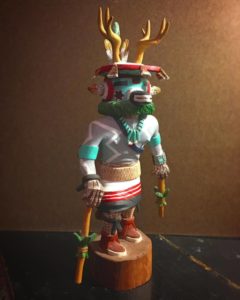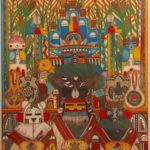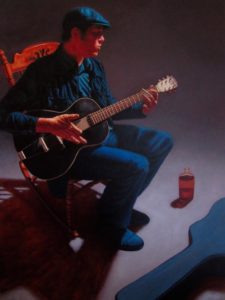
It’s no secret that artists have turned to nature for inspiration since the beginning of time and it seems that the process is still as relevant today as it ever was. Recently I caught up with my old friend, Adam Schrader, who is also an immortalizer of the outdoors and has a knack for capturing a palpable intimacy in his compositions. I first met Adam a few years after he graduated from the Pennsylvania Academy of Fine Arts in 2000 and while I’d always known him to be an artist, I never truly had a sense of the work he did until the past few years when I began to see posts of his projects on social media. I decided to send him my questionnaire about the therapeutic aspects of art making for artists and when we finally got a chance to talk, he led me through a convalescent journey that included inspiration in everything from the solitude of Edward Hopper paintings and the process of immersing himself in the grunt work of prepping canvases, to social dances on the Hopi Indian reservation near Prescott, AZ where he now lives. In some ways I think Adam leads the quintessential artist lifestyle. He works on commissions and is also a dj and drummer in his spare time (or maybe he just is a dj and drummer too). It’s like the creative process radiates through him. I don’t think it’s a coincidence that this is what sustained him through his battle with a chronic medical condition. I hope you’ll find his story to be inspiring as I have.
Why do you create artwork?
Good question. I would say…it’s a form of expression, a way to express myself. I started to draw when I was like 5, I used to copy birds from Audubon books. My grandparents had a big chalkboard and we would draw Cubs games together. Back then I didn’t realize I was expressing myself, I guess it was my pre-formal art education.
Now when I’m making art, I’m in a different mindset than when I’m not doing art. It’s like being a in trance…like running a race…a conscious state that you’re in at a time. It’s the same with music too.
When I’m not doing it, it’s like a loved one is gone, something is missing.
It sounds like when art is not there, it’s like a relationship is missing.
Yeah, it’s like dating someone and then you can’t talk to them anymore. When I go to bed…if I don’t have an art project to think about then I’m thinking about bills. I don’t want to say it’s a distraction…but it is a distraction from difficult thoughts.
What medium do you prefer to work with and why?

Pretty much 2 mediums; oil paint on poplar wood panel, masonite or canvas and charcoal on paper. Oils were the first thing that I really painted with aside from working with acrylics in high school. That’s really what I learned – how to mix paints with oil. For me, it’s the result, the brilliance of the color. You can manipulate it while it’s drying because it doesn’t dry right away. All the artists that drew my eye were oil painters. I did try as many mediums as possible in school, but oil always spoke to me. I use a minimal palette compared to most artists, I mix my own colors. I use like 5 colors, Prussian blue, cadmium red deep, yellow ochre, lemon yellow or windsor yellow (for landscapes) or maples yellow. I use black sparingly, only for certain pieces – just to get specific effect. I use white obviously. I don’t have a green… It’s an organic palette. It’s universal. I can make all the colors using different ratios. A lot of optical vision, knowing how colors change when you change the colors next to them. Charcoal is similar in that you can manipulate it. The darkness… you can keep it painterly or loose. You can tighten it up. The versatility between creating softness and tight lines.
Do you feel that your work has been therapeutic in some way? If so, how?

I feel lost, less grounded if I’m not doing art. I do a lot of landscape art, so you’re in a relationship with nature. Instead of just looking at the clouds, it’s like I’m sculpting with them and having a conversation with them. When you are a landscape painter, you are constantly looking at nature asking how would I paint that, look at that color, it’s a back and forth relationship. There’s something going on that’s bigger than you.
If I’m not doing art, I don’t see the world in the same way. Almost like I’m not seeing it. It’s like you lose part of your vision.
Can you say something about the therapeutic nature of the process?
For me, the process from start to finish…seeing it in your head, sketching it out, going to the store, stretching the canvas, prepping, priming and sanding each coat. The dirty work is what makes it mine. It feels great to do it all myself. It’s like you’re already in it before you even use the first brush stroke. I’m thinking about what’s going to be on there. When you’re having bad days in the studio the grunt work can be grounding. When I get all down on myself…insecure…I’m my own worst enemy as far as my art goes, I’m my own worst critic. Tomorrow I will come in and just do a bunch of grunt work then you feel positive, and can say I was productive. You know you’re not going to mess up…unless you put a staple through your hand. [Yow!] Then seeing your vision come alive and seeing what happens when you do finally finish. Whenever I’m done with a painting, I’m usually on a high, it takes an hour to come down from it. With music I’m the same way, but the kinetic energy of drumming, keeps it going. With oil, you have to wait 6-8 weeks to let it dry before the final varnish. That part is always interesting to me.
I had a professor back in the day, who used to throw paintings out the window. It can also feel great to say I can do it again, so what? and chuck it out the window.
What, if anything, is therapeutic about the finished product?
The sense of accomplishment, especially for my work since I’m tedious and there are many hours involved. The questions…am I ever going to finish this thing? or am I going to ruin it? When it’s done, it’s like seeing a child all grown up. It’s hard to let go of if I have to sell it. Every single painting, I remember where I made it and what the challenges were. So much personal stuff involved. It’s such a process. Kind of like how a song brings back a time and place, my paintings do that for me too.
Has there been a particular time in life when your artwork pulled you through?

Yeah…I would say from 2006 to 2009 art was a big help. Before I moved to Prescott, I had established myself with a community of artists so I got a lot of work right away (like a 24 foot long oil painting inside a restaurant, panels pieced together above the bar) – making art was extremely helpful in healing from chronic medical issues, taking antibiotics and steroids, healing big time, figuring shit out. A healthy and happy distraction. It got my head out of it. Making art for people to see and getting a positive reaction makes you feel good. You feel like you’re doing something for your fellow people – extremely helpful in that aspect.
Has there been a particular time in life when the artwork of others was especially inspirational?
Absolutely. Probably constant. I’m always inspired by other artists. I dive into books. I go online to see what people are doing. Instagram…I would never see some of this work had it not been for social media. After looking at your own stuff for so long, it helps to look at other people’s work. I will ask old friends to ship stuff for inspiration. I love seeing applications, transitions of their work – I can learn about technique this way.

A major healing aspect for me was going up to the Hopi Reservation, that art has touched me more than anything, especially out here for healing. Making baskets, pottery, kachina dolls (kachina means life-bringer, or friend) figures of the Hopi gods – 200 of them – have to be made by Hopi’s, carved from cottonwood root, originally for children but became their own art form. Bringing dolls home brings healing – I have about 60 of them. I go to the social dances they have; Basket dances, Snake dances, Water dance, Bean dance. The men dress up as kachinas – when they dress up, they are no longer themselves, they are embodied by the gods. It’s gorgeous, stuff they’ve been doing for 100’s and 100’s of years. I visit 5 villages, 2 of them are the oldest standing villages in America. When I came out here in ‘05, ‘06 to heal, I would go every weekend. You just watch – there are rules, you don’t point. The dancers, all the kachinas, are the chiefs maybe some aunts and uncles involved. And there’s a ton of food. You sit on the rooftops – branches are used to make homemade ladders to get up there – and they throw food up at you. The Basket dance is reverse where the dancers are on the rooftops throwing stuff down, you have to keep your awareness or you could get doused with gallons of water. There are Eagles and Hawks that are tethered to roof tops – they’re treated w/love and respect – are raised like children then sacrificed by snuffing them out humanely with herbs.

Everything is symbolic – every line in a weaving means something, colors have specific meanings, the swastika is used to represent direction, North, South, East, West. It’s 3rd world up there, there are government issued homes and drug problems. Whenever they invite me up, I always bring a bunch of food and necessities for the houses. I definitely believe it helped me mentally to get through all that shit, my healing.
Has your artwork helped you to find your voice in some way? If so, how?
It just defines who you are. I’ve been drawing my whole life, I identify myself with that. In relationships, it helps you communicate. I’m a little bit introverted, it helps people relate to who I am – if they don’t know me, they can see where I’m coming from.
What artists inspire you? How have you embraced their concepts into your own work?
- Edward Hopper was always one of my favorite artists. There is a small town outside of Prescott called Jerome, I found a spot there which became Hopper inspired.
- Eric Fischle
- Sidney Goodman
- Old Masters from Japan to France (anything 1600’s – 1915) like Ukiyo-E
Are there particular metaphors in your artwork that have been especially meaningful to you in some way? Elaborate.
Solitude – landscapes have a solitude feel to them. Trees, rocks, dells – I see them as figures.
Any last comments? Words of wisdom?

When you’re critiquing your work – remember is that it’s just an opinion…at times I still get discouraged. Halfway through I get stuck. I know what I need to do and I’m afraid I might ruin it. The key is having a tool to get your way out of it – maybe someone else’s advice…Keep true to yourself. If it makes you happy that’s all that counts…No matter what you do, there will be someone who loves it and someone who hates it…I still get turned down in competitions. Know the difference between constructive criticism and opinionated banter…PMA – Positive Mental Attitude – write it on your wall.
And finally some unsolicited feedback about our interview 🙂
This was helpful – it made me think about things and process some issues – I’m kind of an introverted person – it’s nice to put these things out there to gain clarity.
Thanks Adam! Oh, and in case anyone is wondering, it sounds like Adam is physically feeling much healthier these days. He indicated that the medication regimen he’d been on for years was far less helpful than the eventual surgery…but who knew. Talk about process!
Click here to see more of Adam’s work on his website, adamschrader.com.
Copyright 2017 © Rachel Braun, All rights reserved.
Rachel Braun, ATR-BC Art Therapist Philadelphia, PA
Specializing in art therapy groups for women who experience depression, anxiety and eating disorders.